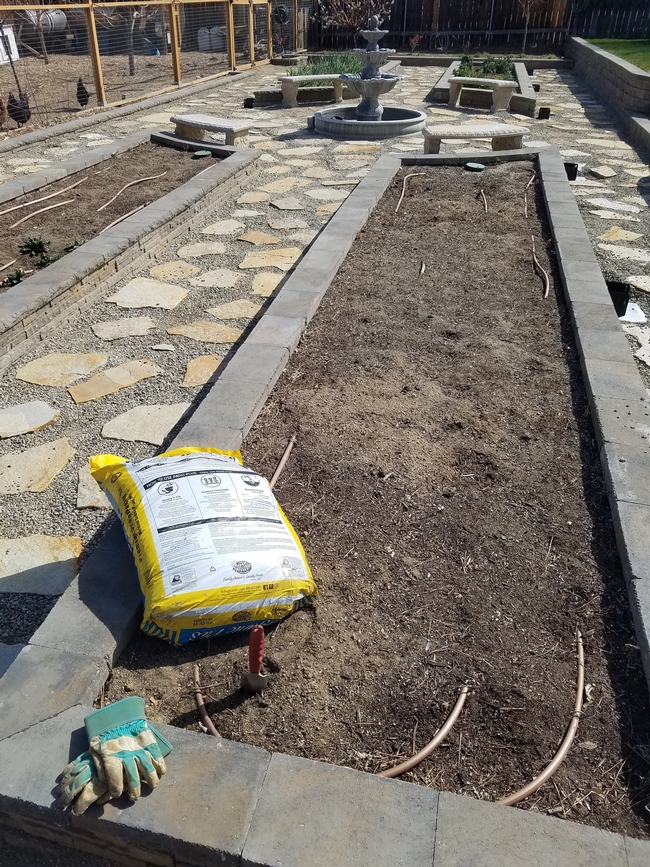It's spring again! Time to start preparing your garden for planting. Read on for some tips to make this year's garden your most successful yet.
The first step in planning a garden is to select a site and amend the soil. Pick a site with good drainage, full sun, access to water, and low traffic. Leave walking room between rows. Never walk on the soil in your garden beds.
Prepare your soil three weeks before you plan to plant. Weed your garden and turn under any cover crops, if you grew any. You will want to loosen the soil 10-12” deep and break up big clods of soil to make it easy for the roots to grow. Do not till very dry or wet soil; soil should be dryish but still able to loosely clump with some effort. You can learn how to double dig your soil by watching the video on YouTube made by our own Master Gardeners: https://youtu.be/KHvgDUd0VS8 .
Next, you can mix in amendments if needed. Soils throughout most of Inyo and Mono Counties are derived from sources in the Sierra. Most soils in our area are well-drained, do not have accumulated salts, and have a good pH for growing plants. However, some communities in our area, such as Chalfant, have soil that is derived from other mountain sources producing alkaline soils that require amending with sulfur before planting. See our local soils page for more information about your local soil.: https://ucanr.edu/sites/newinyomonomg/Eastern_Sierra_Gardening/Soil/Your_Local_Soil_487/
Garden beds should be amended with compost annually. That is especially true here because our desert soils drain water excessively and hold few nutrients. Organic matter, such as compost, improves both the fertility and the texture of the soil. Inorganic fertilizers aim to feed plants and do not affect tilth or the holding capacity of soil. Mix 1-2” of compost or high-quality organic material into the top 4” of your soil with a hoe or a spade. If using manure, make sure it is fully composted. After mixing in the compost, water the bed evenly. Then, let it rest until planting.
If you have terrible soil, you can make raised beds and bring in external soil. Soil in raised beds should be composed of about ½ topsoil and ½ organic matter (mostly compost) by volume. No need to be exact! For more information on raised gardens, visit our website: https://ucanr.edu/sites/newinyomonomg/Eastern_Sierra_Gardening/Vegetables/Raised_Beds/
For best results, many plants require an additional fertilizer. The three primary nutrients plants need are nitrogen, phosphorus, and potassium. Too much fertilizer can affect growth, so only add enough to meet the feeding needs of your plants so be sure to carefully follow directions for application.
Have an irrigation plan before planting. Soil needs to remain evenly moist during germination and throughout the growing season. Soil will dry out to a depth of a few inches in the sun. Below that, only plants can remove the moisture. Insert your finger into the soil to determine if the soil is moist or dry and adjust your watering accordingly. For water efficiency, irrigate at the base of the plants early in the morning or late in the evening. Drip irrigation is best. For information on irrigation, visit our website: https://ucanr.edu/sites/newinyomonomg/Eastern_Sierra_Gardening/Irrigation/
Remove weeds as they arise because they compete with your plants for resources. Usually, weeds can be easily controlled by pulling. If not, you can hoe or possibly use herbicides. Be extremely careful when spraying. Never spray when it is windy because most herbicides will kill your plants too. Always read the label and follow the directions when using herbicides. Most gardeners in our area are able to control their weeds with pulling and hoeing, however.
Now you are ready to plant!
Start warm season crops indoors six weeks before planting. You will want to plant as soon as possible for the longest growing season but after the danger of frost, since frost can kill your plants. As a general rule of thumb, transplant when the soil 4 inches deep is 60 degrees at 10 am.
In Bishop, the last frost occurs after May 5 50% of the time and after May 14 25% of the time. Most years the soil is warm enough to transplant well before the end of frost season.
If there is a frost after you plant, protect your plants by covering them. For more information on starting your vegetable garden, visit our website: https://ucanr.edu/sites/newinyomonomg/Eastern_Sierra_Gardening/Vegetables/Getting_Started/
Have fun with your new garden!
